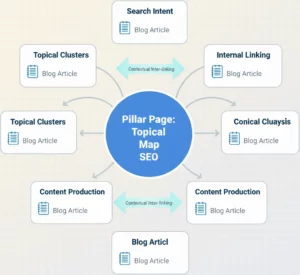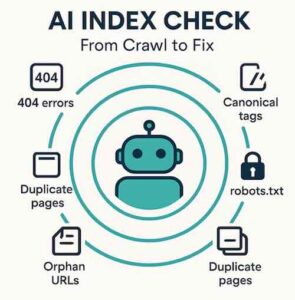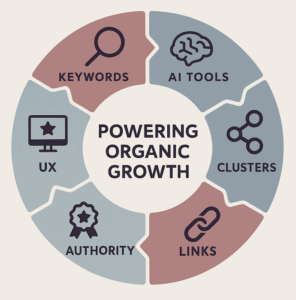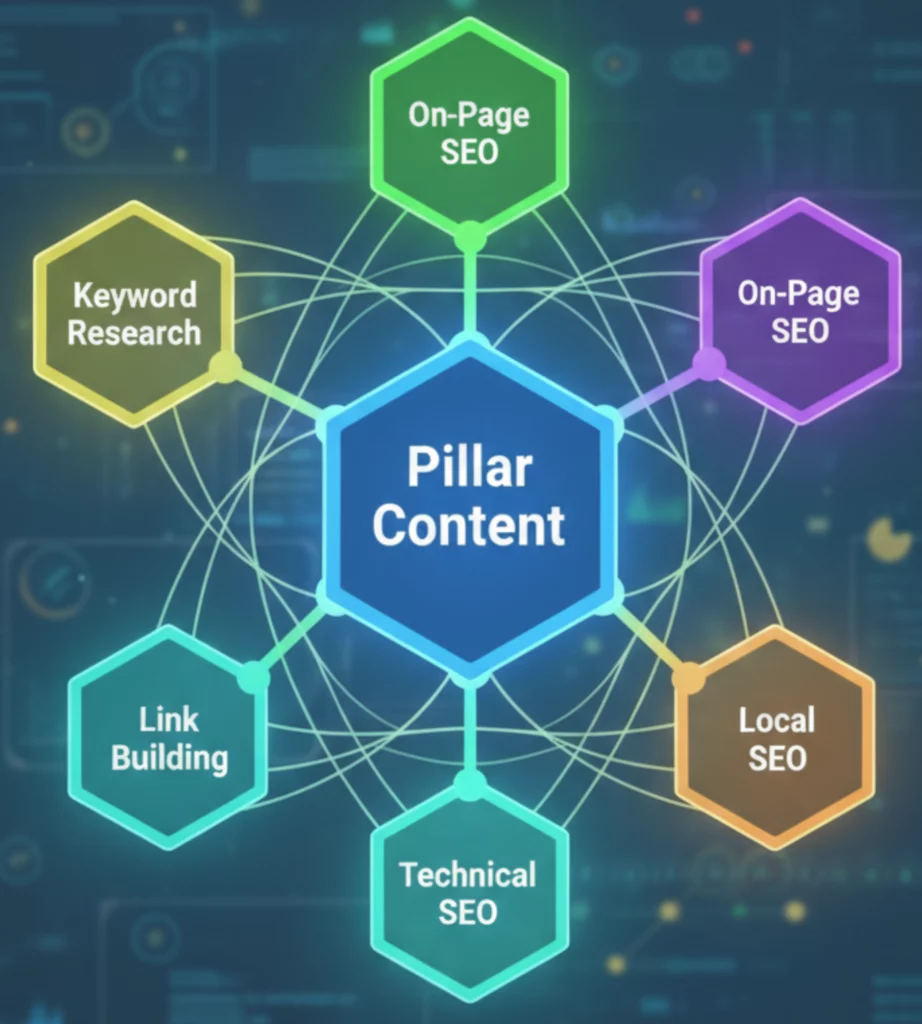
Table of Contents
ToggleKey Takeaways
- Topical authority is now the largest on-page ranking factor. Analysis of 253,800 search results confirms page-level topical authority outweighs even domain traffic volume in Google’s ranking algorithm.
- Free tools provide semantic clustering but lack search intent analysis. Free topical map generators like FatJoe and Akkio offer basic keyword grouping, but paid tools using live SERP data deliver significantly more accurate intent-based clustering for competitive niches.
- Documented case studies show 60% to 3,000%+ traffic growth. Sites implementing comprehensive topical mapping strategies achieved measurable results within 6-12 months across e-commerce, B2B, and niche content sites.
- Start free, upgrade strategically. Free tools work well for initial topic exploration and small sites (under 20 target topics), while paid tools become essential when competing in saturated markets requiring sophisticated intent analysis.
- Quality over quantity drives topical authority. Successful topical clusters typically include 1 pillar page plus 4-15+ supporting articles with strategic internal linking, where comprehensive coverage matters more than arbitrary article counts.
- Small sites can compete through focused topical expertise. RetroDodo achieved 1M+ monthly clicks with a Domain Rating of only 47 by building deep topical authority in retro gaming, proving comprehensive coverage beats broad domain authority.
Understanding SEO Topical Map Generators
Core Functions and Technology Behind Topical Map Tools
At their core, SEO topical map generators are specialized tools designed to help you visualize and structure your website’s content around interconnected topics and subtopics. These tools leverage advanced algorithms, often powered by artificial intelligence and natural language processing (NLP), to analyze search intent, cluster related keywords, and map out content opportunities.
Research shows that pages with strong topical authority gain traffic 57% faster than those with weak authority. By automating the research and organization process, topical map generators save you hours of manual work and ensure your content aligns with how users search.
For example, platforms like Hack The SEO use live SERP crawling and AI-driven analysis to generate topical maps in seconds. This approach allows you to identify gaps, optimize internal linking, and build a strong foundation for search engine optimization. Whether you are a beginner or an experienced SEO specialist, understanding the underlying technology helps you make informed decisions about which generator best fits your workflow.
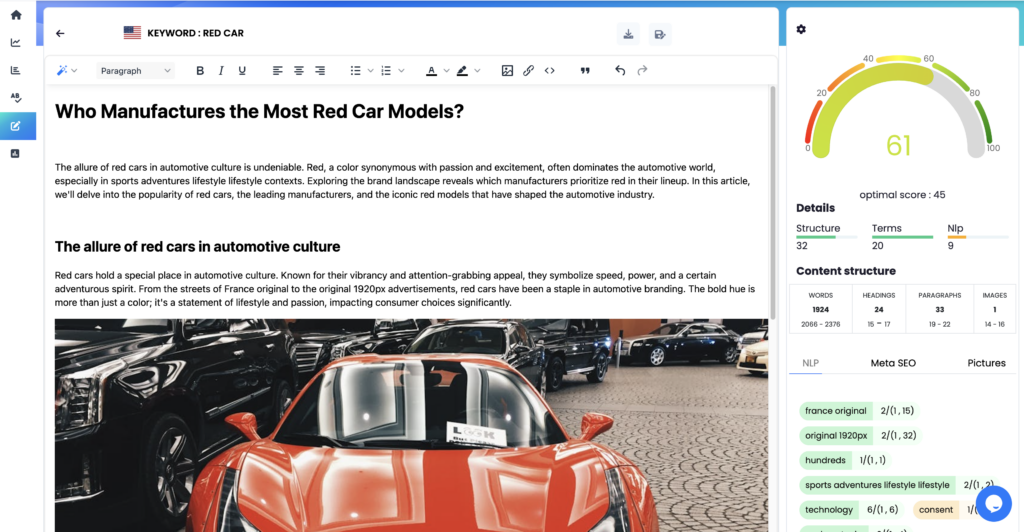
Definition: A topical map generator is a tool that clusters keywords and content ideas into logical topic groups, helping you plan and structure your website for maximum topical authority.
How Topical Maps Enhance Keyword Clustering and Content Strategy
Topical maps are more than just visual diagrams – they are strategic blueprints for your content marketing. By grouping related keywords and subtopics, these maps reveal the relationships between core topics and supporting content.
Data from the 2024 Surfer SEO study reveals that 98% of SEO professionals rate the value of keyword clustering as medium to high in their content strategy, and 80% believe a tool automating clustering based on search results would be highly valuable.
This clustering process not only improves your site’s semantic structure but also boosts your chances of ranking for a wider range of search queries. For instance, if you run a WooCommerce store, a topical map can help you organize product categories, blog posts, and landing pages around high-value keywords. This approach ensures that your content covers all relevant angles, reducing keyword cannibalization and strengthening your topical authority. The result? Increased search traffic, better user experience, and a more coherent content strategy.
Essential Features to Look For in Topical Map Generators
When evaluating topical map tools, certain features stand out as must-haves. Look for generators that offer intuitive keyword clustering, customizable templates, and robust export options. Documentation support is also crucial, especially for beginners who need step-by-step guidance.
Some advanced tools provide AI-powered workflows and visual customization options, enhancing both usability and output quality. Additionally, consider whether the tool supports multiple languages, integrates with your existing platforms, and offers transparent privacy policies.
According to industry research, 54% of SEO and content marketers identify lack of resources and scalable workflows as their biggest challenges, making efficient tool features critical for success.
Visualization, Export, and User Experience Considerations
A great topical map tool should make it easy to visualize complex topic structures and export your maps for further analysis or sharing. Look for interactive interfaces that allow you to drag and drop topics, zoom in on subtopics, and generate reports in standard formats.
User experience is key – tools that are cluttered or difficult to navigate can slow down your workflow and hinder adoption across your team. Export capabilities are especially important if you plan to integrate your topical maps with other SEO tools or share them with stakeholders.
The ability to export to CSV, PDF, or directly to your content management system can save valuable time and streamline your content creation process. In summary, understanding the core technology, features, and user experience of topical map generators is the first step toward building a scalable, effective SEO strategy.
Evidence and Real-World Examples
Case Study: Health Supplements E-commerce
A US-based health supplements retailer implemented a comprehensive topical mapping strategy using the “Power Hubs” model (pillar + cluster content). Over 6 months, the site achieved:
- Traffic Growth: 60.99% increase (4,202 to 6,765 monthly users)
- Keyword Rankings: 188% increase (1,405 to 2,288 keywords in top 100)
- Methodology: 4 supporting articles per main topic, E-E-A-T signals implementation, strategic internal linking
This demonstrates that even in competitive e-commerce niches, focused topical authority can drive significant organic growth. Full case study details.
Case Study: Marketing Services Agency
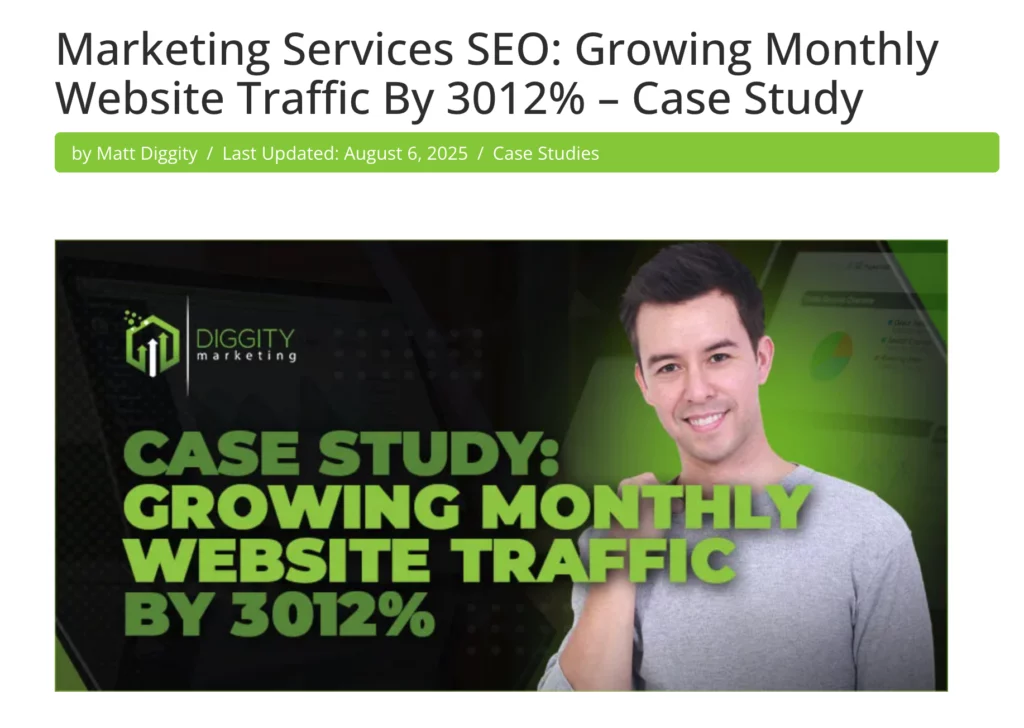
An anonymous marketing agency achieved exceptional results through comprehensive topical coverage:
- Traffic Growth: 3,012% increase (856 to 26,646 monthly users)
- Keyword Visibility: 2,650% increase in top 3 rankings (18 to 495 keywords)
- Strategy: Topic clusters covering breadth and depth of marketing services with strategic internal linking
This case demonstrates the exponential potential of well-executed topical mapping in B2B service industries. Full implementation details.
Case Study: Small Site Competing Against Large Domains
RetroDodo, a retro gaming content site, achieved remarkable success despite weak domain authority:
- Traffic: Over 1 million monthly clicks
- Domain Rating: Only 47 (weak backlink profile)
- Competitive Success: Outranks Buzzfeed and larger sites through focused topical authority
- Keywords: 31,000+ ranking keywords for “pokemon” alone
This proves that comprehensive topical coverage can overcome weak domain authority in competitive niches, offering hope for smaller publishers and new sites. Analysis and insights.
Academic Validation: Search Engine Research
The importance of topical authority isn’t just anecdotal. Analysis of 253,800 search results by WLDM, ClickStream, and Search Engine Journal confirmed that page-level topical authority is the largest on-page ranking factor – more important than domain monthly traffic volume.
This research validates what SEO practitioners have observed: comprehensive topical coverage signals expertise to search engines more effectively than traditional metrics like domain authority or backlink count alone.
Expert Perspectives on Topical Authority
“It’s okay for publications and authors to focus on one niche area where they demonstrate expertise and authority. As an example, if you write about public schools in Brooklyn and you have credibility and authority on that topic, stick to that content. Know your actual credentials and make sure that you are writing within an area that you have credibility, and generally, Google will reward you with visibility on those topics.”
– Lily Ray, VP of SEO Strategy & Research at Amsive Digital (Interview, 2023)
“AI search platforms break complex queries into multiple related subqueries (facets, angles, intents) executed in parallel to retrieve the most relevant content for each aspect. Query fan-out explores different user intents, so targeting a diversity of angles increases coverage. It is even more important than ever to have comprehensive coverage, ideally through topic clusters for each one of the relevant topics that our brands are about.”
– Aleyda Solis, International SEO Consultant (AI Search Optimization Guide, 2025)
“Building topical authority is about helping search engines understand a website’s topic so that it has better potential to rank for topically related keywords. When you create content pieces around the same subject and interlink them, your topical authority in the eyes of Google increases. This helps to show it that you’re knowledgeable, an authority on the topic and a trusted source.”
– Joshua Hardwick, Head of Content at Ahrefs (Ahrefs Blog, 2022)
Free Topical Map Tools: Pros, Cons, and Best Use Cases
Overview of Popular Free Topical Map Generators
Free topical map tools have gained popularity for their accessibility and ease of use. Many platforms, including Hack The SEO’s free topical map generator, offer entry-level solutions that allow users to generate topical maps without any upfront investment.
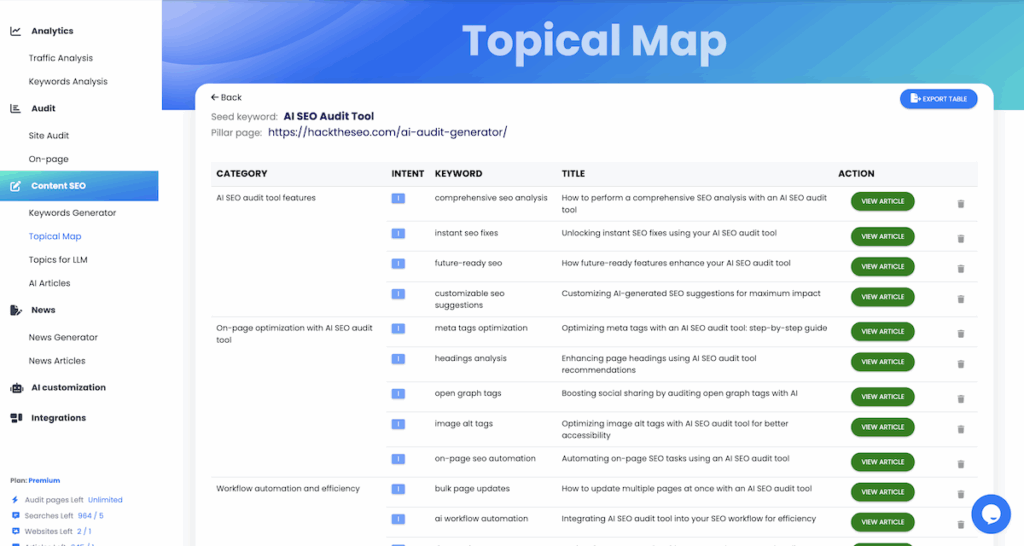
These tools typically provide basic keyword clustering, simple visualization, and limited export options, making them ideal for small businesses, startups, and individuals just starting with SEO. The global SEO software market reached $74.6 billion in 2024, with small and medium enterprises representing a significant portion of tool adoption.
Some free tools also include templates for common content structures, support for multiple languages, and integration with popular platforms. However, the feature set is often more limited compared to paid alternatives, focusing on core functionality rather than advanced customization.
Strengths of Free Tools: Accessibility, Speed, and Simplicity
The primary advantage of free topical map generators is their accessibility. Anyone can sign up and start mapping topics within seconds, without the need for credit cards or lengthy onboarding. This makes free tools perfect for quick research, brainstorming sessions, or testing new content ideas.
Speed is another key benefit. Free tools are often streamlined for rapid performance, allowing you to generate topical maps and identify subtopics with minimal friction. Simplicity is also a hallmark – interfaces are typically user-friendly, with clear instructions and minimal distractions.
For beginners or teams with limited resources, these strengths make free tools an attractive starting point. Data shows that 82% of marketers use SEO tools, demonstrating the widespread adoption and importance of accessible solutions.
Limitations and Common Pain Points with Free Solutions
Despite their advantages, free topical map tools come with notable limitations. Feature sets are often restricted, with caps on the number of keywords, topics, or exports you can perform.
Advanced capabilities such as AI-driven keyword research, live SERP analysis, or sophisticated intent clustering are usually reserved for paid plans. According to industry experts, free tools typically offer 60-80% accuracy compared to premium SERP-based clustering solutions.
A critical limitation highlighted by Thruuu’s analysis is that “free topical map tools use semantic clustering. These tools group keywords solely based on their similarity in meaning. While this approach isn’t entirely wrong, it overlooks a critical factor: user search intent.”
Documentation support may also be limited, making it harder for users to troubleshoot issues or learn advanced techniques. Additionally, free tools may lack robust privacy policy compliance, which can be a concern for businesses handling sensitive data. Finally, customer support is often minimal, with users relying on community forums or basic FAQs.
Best Scenarios to Choose a Free Tool
Free topical map generators are best suited for specific scenarios. If you are exploring new niches, validating content ideas, or working on a small-scale project, a free tool can provide quick insights without financial commitment.
They are also ideal for educational purposes, allowing beginners to learn the basics of topical mapping and SEO with minimal risk. For agencies or businesses with tight budgets, free tools can serve as a stepping stone before investing in more advanced solutions.
However, as your needs grow and you require more sophisticated features, upgrading to a paid tool may become necessary. Research indicates that 46% of B2B marketers plan to increase their content marketing budget in 2025, suggesting growing investment in professional SEO tools.
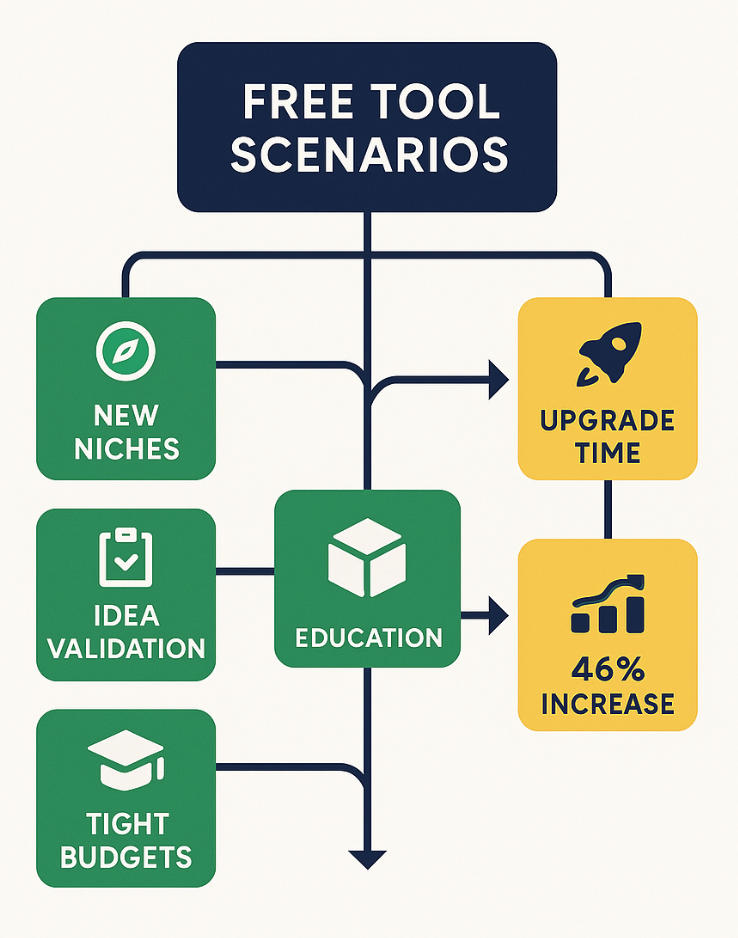
How to Choose the Right Topical Map Tool for Your Needs
Criteria for Evaluating Topical Map Tools (Free and Paid)
Selecting the right topical map generator starts with a clear set of evaluation criteria. Consider the tool’s core features, such as keyword clustering, export options, and integration capabilities.
Assess whether it supports your preferred languages, and check for robust documentation support to help you get started quickly. Other important factors include privacy policy compliance, scalability, and the ability to handle complex content structures.
If you run a WooCommerce store or manage multiple sites, ensure the tool can accommodate your workflow. Look for platforms that offer both free and paid plans, allowing you to scale as your needs evolve. According to recent data, 49% of businesses adopted a hybrid SEO approach in 2024, combining in-house talent with external tool support.
Assessing Ease of Use and Learning Curve
User experience is a critical consideration when choosing a topical map tool. Evaluate the interface for clarity, intuitiveness, and ease of navigation. Beginners should look for tools with guided tutorials, templates, and responsive customer support.
More advanced users may prioritize customization options and integration with existing SEO stacks. A steep learning curve can slow down adoption and reduce the tool’s effectiveness. Trial periods and demo accounts are valuable for testing usability before making a commitment.
Remember, the best tool is one that your team will actually use – so prioritize ease of use alongside feature set. Research indicates that 91% of respondents report that SEO had a positive impact on website performance and marketing goals in 2024, highlighting the importance of effective tool adoption.
Matching Tool Capabilities to SEO Goals
Your choice of topical map generator should align with your broader SEO strategy. If your goal is to build topical authority, look for tools that excel at clustering keywords and mapping subtopics.
For content marketing with a focus on speed and scale, prioritize platforms that automate research and integrate with your publishing workflow. Consider whether the tool supports advanced features like NLP analysis, AI-powered content generation, and integration with popular platforms.
Industry insights show that 47% of marketers are already implementing AI SEO tools to improve research efficiency, and 84% use AI to identify and exploit emerging search trends. Matching capabilities to your specific goals ensures you get the most value from your investment.
Tips for Trialing and Comparing Tools
Before committing to a topical map tool, take advantage of free trials, demo accounts, or limited-feature versions. Test the tool’s performance by generating topical maps for your main keyword and evaluating the quality of the output.
Compare export options, documentation support, and integration capabilities across different platforms. Seek feedback from your team, and consider running a pilot project to assess real-world usability.
Look for platforms with transparent privacy and affiliate policy terms, and prioritize those with responsive customer support. By trialing and comparing tools, you can make an informed decision that aligns with your SEO goals and budget. Data shows that 87% of B2B marketers report that content marketing created brand awareness in the past 12 months, demonstrating the strategic importance of proper tool selection.
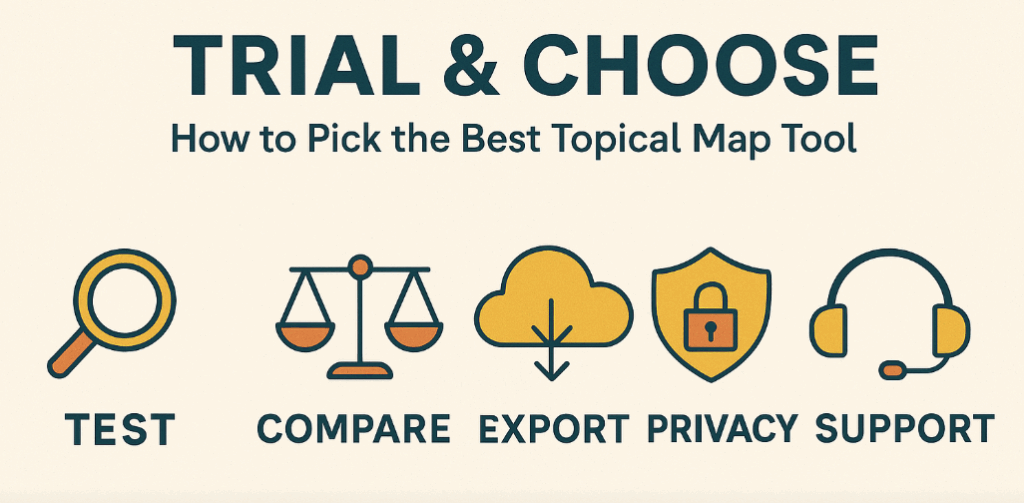
Best Practices for Using Free Topical Map Tools
- Start with comprehensive keyword research using tools like Ahrefs or Semrush before creating your topical map to identify all relevant topics and subtopics.
- Create your topical map BEFORE writing content, not after. The Interingilizce.com case study proved planning topical coverage upfront drives superior results (1,100% traffic growth).
- Plan for 4-10+ supporting articles per pillar topic to ensure comprehensive coverage that signals genuine expertise to search engines.
- Use semantic clustering for initial topic exploration, but validate with SERP analysis for competitive niches where user intent varies significantly.
- Implement strategic internal linking between pillar pages and cluster content (maximum 15 contextual links per page for optimal user experience).
- Focus on search intent, not just semantic similarity. Free tools miss this critical factor – verify intent alignment manually or upgrade to paid tools with SERP analysis.
- Verify topical coverage fills gaps competitors miss. The 253,800 SERP analysis identified comprehensive coverage as the largest ranking differentiator.
- Measure topical authority using metrics like Ahrefs “Traffic Share by Domains” or similar tools to track your progress over time.
- Update and expand topical clusters quarterly to maintain authority as topics evolve and new subtopics emerge.
- Integrate E-E-A-T signals (author credentials, citations, expertise indicators) within your topical content to reinforce trustworthiness.
- Start with free tools for exploration, upgrade to paid tools when competing in saturated markets requiring sophisticated analysis.
- Track featured snippet opportunities within your topic clusters as they provide fast visibility and reinforce topical authority.
Practical Guide: Using a Topical Map Tool for SEO Success
Step-by-Step Process to Create a Topical Map
Creating a topical map is a structured process that begins with defining your main keyword and ends with a comprehensive content plan. Start by entering your target keyword into the generator – many tools, like Hack The SEO, allow you to perform this step in seconds.
The tool will analyze search intent, cluster related keywords, and suggest core topics and subtopics. Next, review the generated map for relevance and completeness. Adjust clusters as needed, add or remove topics, and ensure the structure aligns with your content goals.
Use the tool’s visualization features to explore relationships between topics and identify gaps in your coverage. Real-world results demonstrate the effectiveness: documented case studies show traffic increases ranging from 60% to 2,500% when implementing comprehensive topical map strategies.
How to Identify Core Topics and Subtopics
Identifying core topics and subtopics is crucial for building topical authority. Start by analyzing the keyword clusters generated by the tool – these often represent high-level themes and supporting content ideas.
Look for patterns in search intent, volume, and competition to prioritize which topics to target first. For example, if your main keyword is “WooCommerce SEO,” core topics might include on-page optimization, technical SEO, and content marketing with product pages.
Subtopics could cover schema markup, internal linking, and specific WooCommerce optimization tactics. This granular approach ensures your content addresses all relevant aspects of the topic. According to a 2024 WLDM and ClickStream study analyzing 253,800 search results, page-level topical authority is the most important on-page ranking factor for Google results.
Grouping and Mapping Related Keywords for Content Planning
Once you have identified core topics and subtopics, group related keywords under each theme. This process helps you plan pillar pages, supporting articles, and internal linking structures.
Use the tool’s export features to create a content calendar or roadmap, assigning topics to specific authors or publication dates. Effective keyword grouping also reduces duplication and ensures your content creation process is efficient.
By mapping keywords to specific pages, you can optimize for both user intent and search engine algorithms, driving more targeted search traffic to your site. Industry data reveals that nearly 90% of SEO professionals prefer tools that automate clustering based on their input data, Google Search Console, or competitor data.
Exporting, Integrating, and Acting on Your Topical Map
After finalizing your topical map, export it in your preferred format – CSV, PDF, or direct integration with your CMS. Share the map with your team, stakeholders, or clients to align on content strategy and priorities.
Use the map as a living document, updating it regularly as you publish new content and track performance. Integration with platforms like WordPress or other content management systems can further streamline your workflow.
By acting on your topical map, you ensure that every piece of content contributes to your overall SEO goals and topical authority. Research shows that 63% of respondents report that Google’s AI Overviews have had a positive impact on organic traffic, visibility, or rankings since their May 2024 rollout, making comprehensive topical coverage even more critical.
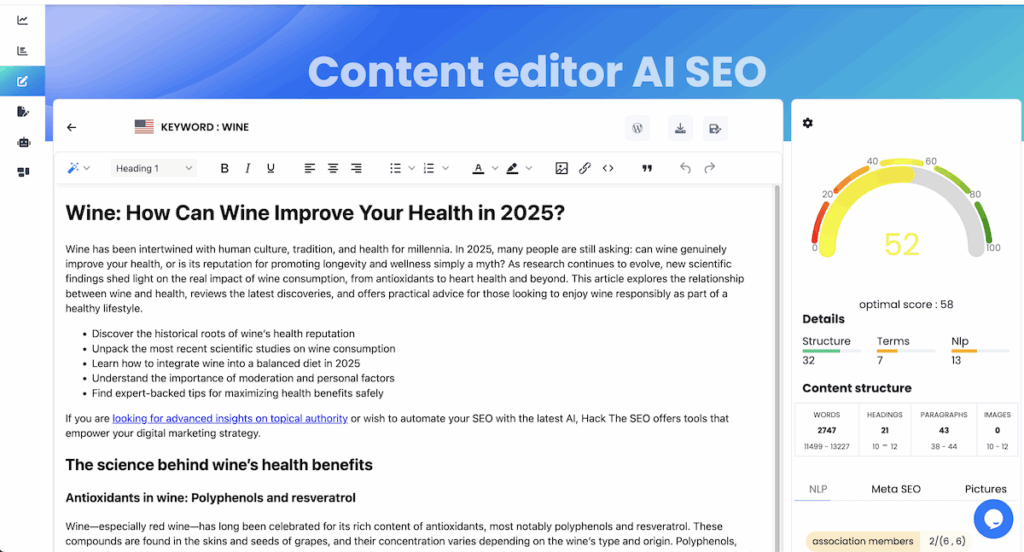
Free vs. Paid Topical Map Tools: Key Differences
| Feature | Free Topical Map Tools | Paid Topical Map Tools |
|---|---|---|
| Keyword Clustering | Basic (60-80% accuracy, semantic only) | Advanced (AI/NLP-powered, SERP-based, intent-aware) |
| Export Options | Limited (CSV/PDF) | Comprehensive (CMS integration, templates, multiple formats) |
| Documentation Support | Minimal | Extensive (guides, tutorials, dedicated support) |
| Customization | Low | High (customizable workflows, AI assistance) |
| Privacy & Compliance | Basic | Robust (comprehensive privacy policy, compliance features) |
| Best For | Beginners, small projects, budget-conscious users | Agencies, e-commerce, enterprises, competitive niches |
Maximizing ROI: Combining Free Topical Map Tools and Paid Approaches
How to Leverage Both Free and Paid Tools for Best Results
Combining free and paid topical map tools can yield the best of both worlds. Start with a free tool to brainstorm ideas, validate concepts, and perform initial research. As your needs grow, transition to a paid solution for advanced clustering, integration, and analytics.
This hybrid approach allows you to maximize value while minimizing costs. For example, use Hack The SEO’s free topical map generator to map out initial topics, then upgrade to a pro plan for deeper analysis and workflow automation.
This strategy ensures you always have the right tool for the job, without overcommitting resources. Industry data shows that organizations with higher SEO maturity are more likely to use fully integrated enterprise platforms, but starting with free tools provides a strategic entry point.
Workflow Suggestions for Scaling Topic Research
To scale your topic research, establish a repeatable workflow that leverages both free and paid tools. Begin with broad keyword research using a free generator, then refine your clusters and subtopics with a paid platform.
Use export features to create a content calendar, assign tasks, and track progress. Regularly review your topical map to identify new opportunities, update existing content, and ensure alignment with your SEO goals.
By standardizing your workflow, you can efficiently manage large-scale content marketing with minimal manual effort. Research indicates that 40% of marketers plan to increase investments in AI for content optimization, and 39% for AI-powered content creation in 2025.
Avoiding Common Mistakes and Pitfalls
When combining free and paid tools, avoid common pitfalls such as duplicating efforts, neglecting documentation support, or overlooking privacy policy requirements. Ensure that your workflow is streamlined, with clear handoffs between tools and team members.
Regularly audit your topical map for accuracy, completeness, and relevance. Stay up to date with platform updates, new features, and best practices to maintain a competitive edge.
By proactively addressing potential issues, you can maximize the ROI of your topical mapping efforts. Data reveals that 54% of marketers cite lack of resources as a major challenge, and 45% lack a scalable model for content creation, emphasizing the importance of efficient workflow design.
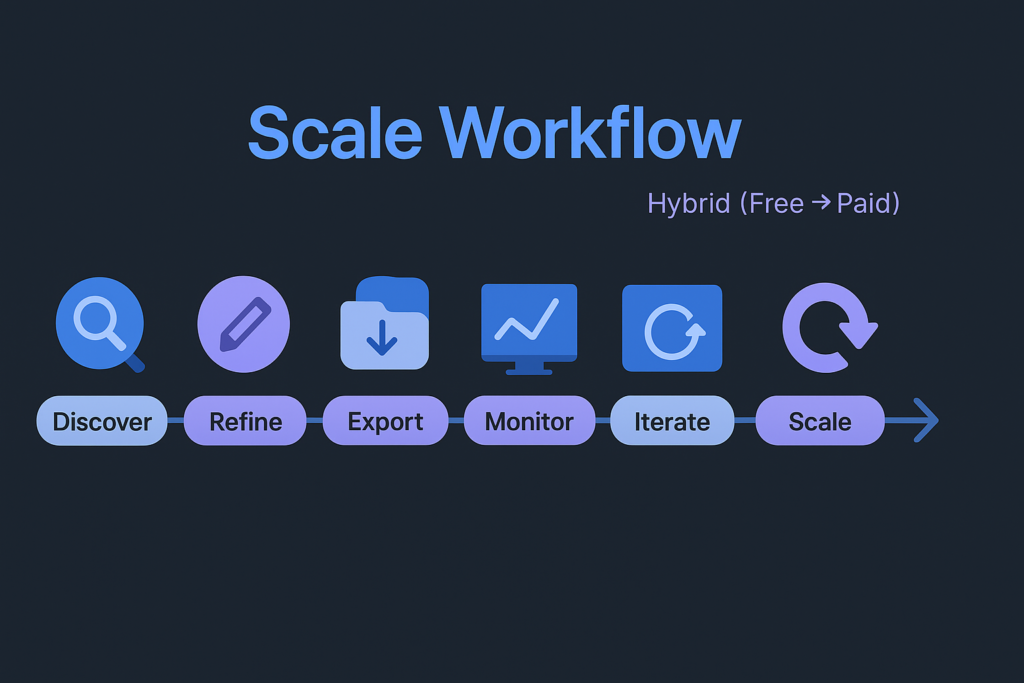
Frequently Asked Questions
What is a topical map in SEO?
A topical map in SEO is a visual representation of how core topics, subtopics, and related keywords are organized on your website. It helps structure your content for better topical authority and improved search engine rankings. According to Google’s patent US8458196B1, topical authority is determined by calculating the percentage of pages covering specific topics, validating this strategic approach.
Can I create an SEO topical map without specialized tools?
Yes, you can manually create a topical map using spreadsheets or mind-mapping software. However, specialized topical map generators automate keyword clustering, save time, and provide deeper insights, especially for large sites or complex topics. Research shows that 90% of SEO professionals prefer tools that automate clustering processes.
How do topical maps directly impact search rankings?
Topical maps help you cover all relevant aspects of a subject, improving your site’s topical authority. A 2024 study of 253,800 search results found that page-level topical authority is the most important on-page ranking factor. This comprehensive coverage signals to search engines that your site is a trusted resource, leading to higher rankings and increased search traffic. Pages with strong topical authority gain traffic 57% faster than those with weak authority.
Are free topical map generators reliable for professional use?
Free topical map generators are reliable for basic research, brainstorming, and small projects. They typically offer 60-80% accuracy compared to premium SERP-based solutions. For advanced needs such as large-scale content planning, competitive analysis, or integration with other tools, paid solutions offer more robust features and support. According to experts, free tools are viable when combined with manual refinement and intent verification.
What should I consider before investing in a paid topical map tool?
Before investing, evaluate the tool’s features, documentation support, privacy policy compliance, and integration capabilities. Trial the platform, compare pricing models, and ensure it aligns with your SEO goals and workflow requirements. Consider that organizations with high SEO maturity are significantly more likely to use integrated platforms, but 46% of B2B marketers are increasing budgets in 2025, signaling growing willingness to invest in quality tools.
How long does it take to see results from topical mapping?
Case studies show measurable results in 4-6 months, with optimal authority achieved in 12-24 months. The Graphite study found pages with high topical authority get visibility 57% faster than low-authority pages, reaching traffic within the first week in 62% of cases. Consistent implementation and comprehensive coverage accelerate results.
Summary: Making the Right Choice for Your SEO Strategy
Choosing between free and paid topical map tools depends on your goals, budget, and workflow. Free tools offer speed and simplicity for quick research, while paid solutions provide advanced features and scalability for professional SEO teams.
By understanding the strengths and limitations of each, you can build a content strategy that drives measurable results. With 88% of SEO professionals considering topical authority very important and documented case studies showing traffic increases of 60% to 2,500%, the strategic use of topical map tools has never been more critical.
- Start with free topical map tools for initial research and brainstorming
- Upgrade to paid solutions as your needs grow and workflows become more complex
- Regularly review and update your topical map to maintain topical authority
- Leverage both free and paid tools for maximum flexibility and ROI
Explore free topical map tools from Hack The SEO to get started today.
References
- Surfer SEO (2024). “Topical Authority Study: Survey of SEO Professionals.” https://surferseo.com/blog/topical-authority-study/
- Van Buskirk, E., WLDM, ClickStream (2024). “260k Search Results Analyzed: How Google Evaluates Content.” Search Engine Journal. https://www.searchenginejournal.com/search-results-analyzed-how-google-evaluates-content/518998/
- Graphite (2024). “Topical Authority White Paper.” https://graphite.io/five-percent/topical-authority-white-paper
- Indig, K. (2025). “How to Measure Topical Authority.” Growth Memo. https://www.growth-memo.com/p/how-to-measure-topical-authority
- Conductor (2025). “The State of SEO in 2025.” Conductor Academy. https://www.conductor.com/academy/state-of-organic-marketing/
- Grand View Research (2024). “SEO Software Market Size, Share & Growth Report, 2030.” https://www.grandviewresearch.com/industry-analysis/seo-software-market-report
- Business Research Insights (2024). “AI SEO Software Tools Market Report.” https://www.businessresearchinsights.com/market-reports/ai-seo-software-tools-market-112824
- Content Marketing Institute (2024). “B2B Content Marketing Benchmarks, Budgets, and Trends: Outlook for 2025.” https://contentmarketinginstitute.com/b2b-research/b2b-content-marketing-trends-research
- Google Inc. (2013). “System and method for determining topic authority.” U.S. Patent No. US8458196B1. https://patents.google.com/patent/US8458196B1/en
- Ray, L. (2023). “Interview: E-E-A-T, Topical Authority, and AI.” SEO for Journalism. https://www.seoforjournalism.com/p/lily-ray-eeat-topical-authority-ai
- Solis, A. (2025). “The AI Search Content Optimization Checklist.” https://www.aleydasolis.com/en/ai-search/ai-search-optimization-checklist/
- Hardwick, J. (2022). “What Is Topical Authority? How to Build It.” Ahrefs Blog. https://ahrefs.com/blog/topical-authority/
- Diggity Marketing (2024). “SEO Topical Authority Case Study.” https://diggitymarketing.com/seo-topical-authority-case-study/
- Diggity Marketing (2024). “Marketing Services SEO Case Study.” https://diggitymarketing.com/marketing-services-seo-case-study/
- Thruuu (2024). “Our Review of 5 Free SEO Topical Map Tools.” https://thruuu.com/topic-cluster-content-strategy/seo-topical-map-tools/

Eric Ibanez
News Writer & Founder Hack The SEO
An expert in SEO since the launch of his e-commerce dedicated SaaS in 2016, Eric quickly grasped the significance of optimization for search...
Suggested Articles


